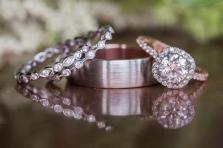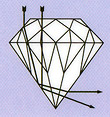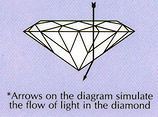| 212-751-3940 | Contact us |
| 5th Ave Showroom | Recently Viewed |
 |
||


 |
 |
 |
 |
 |
 Diamonds
Diamonds
Determining the Value of a diamond, The Four C's.
The "Four C's" - Carat weight, color, clarity, and cut - explain why diamonds range in value:
Carat Weight. The larger a diamond, the more rare
The size of a diamond is measured on a diamond weighing scale by carat weight. Just as there are 100 cents in a dollar, there are 100 points in a carat. If you have 75 cents, you have three-quarters of a dollar. If you have a diamond weighing 75 points, you have three-quarters of a carat. A diamond weighing 100 points equals one carat.
The price per carat rises dramatically as the diamond increases in size, simply because larger diamonds are rarer, and found less frequently.
Diamonds of the same carat weight vary widely in price, because of other factors which include clarity, cutting or proportion, and color.
Color. The whiter the color in a diamond, the more rare.
Diamonds occur in a wide range of colors from light yellow to brown, to the rarest, which have no color at all.
Diamonds are graded by color with letter grades, which begin with "D" (colorless) and continuing down through the alphabet.
Virtually all diamonds exhibit at least a slight shading of yellow
color when graded by a diamond professional. Many will still be
quite beautiful, though, with yellow color, less rare, and, therefore,
less valuable.
|
||||||||||
 |
| COLOR GRADING SCALE | ||||||||||||||||||||||||
| AGS | 0 | .5 | 1.0 | 1.5 | 2.0 | 2.5 | 3.0 | 3.5 | 4.0 | 4.5 | 5.0 | 5.5 | 6.0 | 6.5 | 7.0 | 7.5 | 8.0 | 8.5 | 9.0 | 9.5 | 10.0 | Fancy Yellow | ||
| GIA | D | E | F | G | H | I | J | K | L | M | N | O | P | Q | R | S | T | U | V | W | X | Y | Z | Fancy Yellow |
| Colorless | Near Colorless | Faint Yellow | Very Light Yellow | Light Yellow | ||||||||||||||||||||
Clarity. The Purer a diamond, the more brilliant.
Clarity refers to the internal clearness or purity of the diamond.
There are few perfect diamonds from Mother Nature! Almost all diamonds have internal characteristics - visible under ten power or higher magnification. These inclusions are frequently invisible to the naked eye, and may be considered to be nature's birthmarks. They frequently look like tiny crystals, clouds or feathers.As a diamond's inclusions are more obvious, they affect the passage of light through the stone, and thereby affect its brilliance. As a diamond has more or larger inclusions, the clarity grade is lower, and the diamond is less rare.
IF VVS1 - VVS2 VS1 - VS2 SI1 - SI2 I1 - I3 Internally flawless, no natural characteristics visible under 10x magnification. Extremely rare. Minute characteristics, extremely hard to see even under 10x magnification. Extremely rare Very minor characteristics. Difficult to see even with magnification. Slight characteristics that can be seen under 10x magnification. Characteristics are visible to the naked eye.
CLARITY GRADING SCALE AGS 0 0*** 1 2 3 4 5 6 7 8 9 10
GIA Flawless IF VVS1 VVS2 VS1 VS2 SI1 SI2 I1 I2 I3
Cut. The better a diamond is cut or proportioned, the more brilliant it is.
When a diamond is cut to good proportions by a master craftsman, the diamond can then - most efficiently - take white light, and refract that light into all the brilliant colors of a rainbow, thereby releasing its fire, sparkle and beauty. And you can't buy a rainbow!
A diamond that is cut too deep or too shallow is simply not efficient
at refracting light. The result is a less brilliant and less beautiful
diamond. It is also a less valuable diamond as compared to a well-cut
stone.
| INFERIOR CUT | |
| TOO DEEP | TOO SHALLOW |
| When a diamond is cut too deep, light* leaks out of the bottom, brilliance is lost and the center of the diamond will appear to be dark. | When a diamond is cut too shallow, light* leaks out of the bottom, brilliance is lost and the diamond appears watery, glassy and dark. |
 |
 |
608 Fifth Avenue (corner 49 Street) Suite 509, New York, NY 10020 212-751-3940
608 Fifth Avenue Suite 509
(corner 49 Street)
New York, NY 10020
212-751-3940
Thank you!



